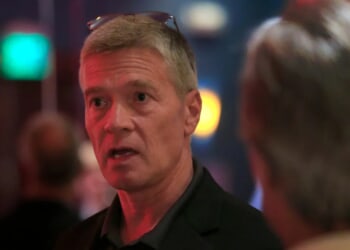
Order Michael Finch’s new book, A Time to Stand: HERE. Prof. Jason Hill calls it “an aesthetic and political tour de force.”
Nuremberg is a 2025 historical drama written, directed, and co-produced by James Vanderbilt. Nuremberg is a misnomer; the film is not an exhaustive treatment of the thirteen trials of Nazi war criminals that took place in Nuremberg, Germany, between 1945 and 1949. A more accurate title for the film would be Five Men at Nuremberg, those five men being SCOTUS Justice Robert H. Jackson (Michael Shannon), psychiatrist Dr. Douglas Kelley (Rami Malek), Hermann Goering (Russell Crowe), Sergeant Howard Triest (Leo Woodall), and Colonel Burton C. Andrus (John Slattery). Jackson played a key role in initiating the Nuremberg trials. Goering was a top Nazi defendant. Kelley was a thirty-two-year-old Army psychiatrist and lieutenant colonel tasked with assessing the Nazi defendants’ mental fitness to stand trial. Triest was a US Army interpreter, and Andrus was the commandant of the Nuremberg prison. Richard E. Grant stars as British prosecutor Sir David Maxwell-Fyfe, and Colin Hanks plays a US Army psychologist, Dr. Gustave Gilbert. Nuremberg is roughly two and a half hours long. Nuremberg opened in the US on November 7, 2025.
Please go see this movie. Buy a ticket; see it in a theater. It’s a good movie, and it’s for grown-ups. If we want movies like this, we have to support them with our ticket purchases.
It’s been a while since I’ve seen a prestige Hollywood production that managed to do all of the following. Nuremberg has a coherent plot. In spite of its runtime, the film’s pace is fast. I’ve seen it twice, and I was never bored. It features recognizable and coherent human characters facing significant obstacles and, in some cases, overcoming those obstacles; in other cases, characters are crushed by those obstacles. Each character’s fate makes sense in relation to the storyline they are living out and their own internal makeup. This equation – a recognizable human character v. a challenge we all might face and rising or falling in the face of that challenge – has been the fulcrum of drama at least since the ancient Greeks.
The actors taking on these roles are charismatic, award-winning professionals who know how to command the screen, arrest your attention and sympathy, and immerse you in the story. In interviews they convey a sense of respect and commitment to the grave subject matter. Russell Crowe as Goering is getting all the attention, but I was in awe of Leo Woodall’s low-key performance as Triest. Towards the end of the movie, after I’d been thoroughly entertained by all that had preceded this moment, in a quiet, subtle series of scenes, Woodall / Triest surprised me by wringing spontaneous tears from my eyes. I don’t want to spoil this moment for you, but it’s one of the most beautiful and profound moments I’ve ever seen in any film, and if you take a quick bathroom break, or dip too deeply into your popcorn, you will miss it, so pay attention.
I like watching Rami Malek in anything and his intense, driven, intelligent performance is exactly right for Kelley. I fell in love with John Slattery’s unsmiling depiction of Colonel Andrus, the commandant of the Nuremberg prison. When Andrus throws Hess against a wall and informs him that he is never to give another sieg heil during his remaining time on earth, I wanted to award Slattery an honorary Oscar. Grant brings old school glamour; he takes Goering down with a velvet glove. Secondary cast members, especially those playing Streicher and Ley, are very good.
The film revisits an historical era and the heaviest of topics, but the script is witty and crisp. It moves like a well-oiled machine. It asks why people commit atrocities and how we can understand and respond to those who commit atrocities. Amidst the unavoidable horror, there are earned moments of laugh-out-loud humor, for example, Nazi Julius Streicher’s response to a Rorschach test.
Nuremberg looks good. You’ve got a bombed out post-war German city, throngs of extras in period clothing, (mostly Hungarian; the movie was filmed in Hungary), and what appear to my civilian eyes as authentic military uniforms. The Palace of Justice courtroom, site of the Nuremberg trials, “was replicated to the inch using the actual building plans” according to Vanderbilt.
Nuremberg is free of artsy-fartsy cinematic pretensions such as those that weighed down Luca Guadagnino’s recent films, Queer and After the Hunt. Moviegoers will not be scratching their heads wondering what the heck is going on onscreen. Even so, there are a couple of scenes that use artistry to make a point. One scene features only a length of Manila rope – the kind reportedly used to hang Nazis at Nuremberg. The rope stretches taut; under strain, individual fibers branch out and catch light. The rope is further stretched; we hear the fibers creak. The rope sways.
In another scene, Triest and Kelley enter a bombed-out library at night. The only illumination in the darkness are the beams from their flashlights. This scene is a metaphor for the human need to comprehend the incomprehensible. Kelley is excited. He has an idea. He will conduct research and discover what made the Nazis do what they did. He will enable the world to prevent atrocity from ever happening again. He will describe what makes Germans “different from us Americans.” Triest, the younger man, is taken aback by that last pronouncement. We won’t learn, till later in the movie, why Triest has been so visibly affected. Towards the end of the film, we will also learn how Kelley’s words here come to have such grim resonance for Kelley himself.
Great Holocaust films include Stanley Kramer’s 1961 masterpiece, Judgment at Nuremberg, Steven Spielberg’s 1993 Schindler’s List, Roman Polanski’s 2002 The Pianist, and Jonathan Glazer’s 2023 Zone of Interest. Nuremberg is not in that class, but it is a very good film, and well worth your time.
Now that I’ve done my best to try to convince you to buy a ticket for Nuremberg, here is some historical background of the actual event and also the making of the film. After the Allied victory on VE Day, May 8, 1945, the Allies faced an impossible question. As Americans and her Allies moved east, and as the Red Army moved west, they discovered the unspeakable. On January 27, 1945, the Red Army liberated Auschwitz. On April 29. 1945, American troops liberated Dachau. Even before these dates, Americans had heard reports of atrocities, and occupied people in Europe had witnessed them. Americans, too, were victims of atrocities. In the December 17, 1944, Malmedy Massacre, Waffen-SS members used machine guns to massacre surrendered American soldiers. In the August 26, 1944, Rüsselsheim Massacre, German civilians used sticks, boards, bricks, rocks, hammers, and shovels to beat American airmen to death. There were other such incidents.
For years, Americans had viewed film footage of millions of ecstatic Germans smiling, cheering, and celebrating Adolf Hitler. At the Nuremberg trials, maps were shown marking the location of concentration and death camps throughout Nazi-occupied Europe. These sites pock the map the way that scars cover the face of a small pox survivor. Most people have heard of Auschwitz. Auschwitz was not alone. The National World War II Museum states, “The Nazis created at least 44,000 camps, including ghettos and other sites of incarceration, between 1933 and 1945. The camps served various functions, from imprisoning ‘enemies of the state’ to serving as way stations in larger deportation schemes to murdering people in gas chambers.” Everyone in Germany was within stench distance of a site of atrocity.
After their defeat, Germans, including Goering, insisted, paraphrase, “I knew nothing.” Gestapo chief Ernst Kaltenbrunner was “a prime figure in the ‘Final Solution.’” At Nuremberg, Kaltenbrunner insisted that it was his position that “Any personal or physical persecution of Jews was completely unnecessary,” and that he had not signed documents that plainly bore his signature. He also insisted that he was unaware of the Final Solution that he himself helped carry out.
Other Germans complained that it was they who were the real victims. Benjamin Ferencz was the chief prosecutor for the United States Army at the Einsatzgruppen trial. Einsatzgruppen were Nazi death squads who committed mass murder, primarily through shooting. Estimates of their kill count run between 1.5 and 2 million human beings, most of them Jews. The Einsatzgruppen also killed an estimated 50,000 Poles, tens of thousands of Roma people, and Soviet officials.
Ferencz reports that the mass killers he prosecuted insisted that they were the real victims. Some claimed that they would be shot if they refused to commit mass murder. But there are no records of any such refusals or military executions. Commander Otto Ohlendorf provided his own humanitarian bona fides. He told his men to stop tossing Jewish babies into the air and using them as target practice, or bashing babies’ heads against trees. He taught his men to have mothers hold babies and shoot the baby, thus killing both mother and child at once, to save on ammo. Others said that they were merciful because they delivered kill shots to still-living victims in mass graves. Still others said that they were victims because they had to “wade through Jewish blood up to their knees” when performing their work. None, Ferencz said, took responsibility for their actions or expressed regret.
Ferencz was aware that Ohlendorf was the father of five children, and that he was about to hang. Ferencz, on his own initiative, and out of human compassion, visited Ohlendorf at the “death house.” Ferencz spoke to Ohlendorf in the mass murderer’s native German. “Herr Ohlendorf,” Ferencz asked. “Can I do something for you?” Ohlendorf replied only, “The Jews in America will suffer for what you have done.” Ohlendorf showed “no remorse whatsoever.” Ferencz says that “only four” Einsatzgruppen leaders were executed at Nuremberg. “There were three thousand members of the Einsatzgruppen. What happened to them? Nothing. Nothing. Was justice done? What is justice? Talk about justice is really totally inadequate.”
Figuring out how to administer justice to an entire country as morally compromised as post-war Germany was one problem. But there was another. America was a leader in the post-war world and more Americans claimed German ancestry than claimed ancestry from any other country. There were a lot of Mullers, Schneiders, Meyers and Fischers on both sides of the Atlantic. Germany was not just related to the rest of the West in terms of genes and culture. It was also economically and militarily important, especially in the Cold War. It would be impossible to punish every guilty party in post-war Germany. It would also be self-sabotaging.
Finally, post-war Germany needed traffic cops, teachers, doctors. Many were former Nazis and war criminals, but Germany needed them to run the country. Historian Jochen Hellbeck reminds us that “As late as 1966,” former Nazis constituted the majority in the West German Ministry of Justice and Federal Criminal Police Office.
Immediately after the war, though, many in Allied nations would have been happy to relegate Germans and Germany to the trash heap. In a 1945 American Institute of Public Opinion poll, nine options were offered in response to, “After the war is over, how should we treat Nazi leaders?” The most popular reply, at 41%, was “kill them.” The next most popular, at 18%, was “punish,” followed by “imprison,” at 13%. “Torture” got a 7% approval rating. Only 10% voted for “trials.”
Stalin suggested that 50,000 Nazi military leaders should be executed. Failing that, he thought that Soviet-style show trials would have terrific propaganda value. Roosevelt pondered dropping an atomic bomb on Germany. “Roosevelt informed me if the European war was not over before we had our first bombs he wanted us to be ready to drop them on Germany,” wrote General Leslie Groves in his memoir. Roosevelt “was quite disturbed over the Battle of the Bulge and he asked me at that time whether I could bomb Germany as well as Japan,” Groves said in an interview.
Churchill wanted summary executions. “The British government opposed the establishment of the Nuremberg war crimes tribunals … because it wanted selected Nazi leaders to be summarily executed and others to be imprisoned without trial, according to a contemporary account that is declassified on Friday. Winston Churchill made the proposal at the ‘Big Three’ conference at Yalta in February 1945, according to the account,” reports the Guardian. German-American Hollywood star and anti-Nazi Marlene Dietrich said, “Germany deserves everything that’s coming to her.”
In short, the Nuremberg trials were not inevitable. People deeply invested in the rule of law, the value of civilization’s defeat of nihilistic evil, and the importance of evidence pushed hard to make them happen. This was not easy because there was no precedent and all involved would have to come to some agreement of how to reconcile conflicting demands of different countries’ legal systems. Today we gripe at the incompleteness of the trials’ reach. Maybe millions of criminals escaped justice. In fact we should rejoice that the trials took place at all. They produced thorough documentation proving the perpetrators’ guilt. Stalin’s idea of summary executions might tempt us, but it would produce its own problems. Some would argue that the executioners were no better than those whose lives they ended. The executed could be celebrated as martyrs. Instead we have video of Goering, Streicher, Hess, Kaltenbrunner, in the dock, squirming like the lowlifes that they were, trying to escape the truth.
In 2011, Minnesota science writer Jack El-Hai outlined a book proposal treating the work of Dr. Douglas Kelley, a lesser-known character of the trials. Many psychiatrists and psychologists, from several countries, studied Nazi prisoners. One of them was psychiatrist Kelley. Kelley was born in Truckee, California. Kelley, a straight-A student and Eagle Scout, had received degrees at Columbia, UC Berkeley, and UCSF. His grandfather, Charles McGlashan, was an historian, journalist, lawyer, educator, entomologist, and active opponent of Chinese immigration. McGlashan researched and published on the Donner Party, and he helped establish a monument to the doomed wayfarers. Kelley’s mother was one of the first women admitted to the California bar. His father was a dentist. Kelley came from a family of intelligent high achievers who blazed their own paths. El-Hai describes Kelley as a driven man, convinced of his own importance, determined to make his mark on the world.
At Nuremberg, Kelley used intelligence tests and Rorschach tests. Kelley wanted to find a “Nazi virus” that could explain evil. If evil could be explained, horrors like the Nazi Era could be prevented. Kelley wrote, “The near destruction of modern culture will have gone for naught if we do not draw the right conclusions about the forces that produced such chaos. We must learn the why of the Nazi success so we can take steps to prevent the recurrence of such evil.” El-Hai says that a sort of bond formed between Nuremberg prisoner Hermann Goering and Kelley. Both were intelligent, manipulative, competitive, and trying to use the other to achieve their own ends. Goering wanted the trial to be his testament. Someday, Goering protested, people would come to appreciate Nazism for the heroic movement it really was, and erect statues in his honor. “In 50 or 60 years there will be statues of Hermann Goering all over Germany. Little statues, maybe, but one in every German home.”
El-Hai describes Kelley’s motivations. “Instead of repelling Kelley, Goering’s brutality heightened the psychiatrist’s determination to reach some understanding of the captive’s personality. Over time, Kelley built an unusually close relationship with Goering. The two men spent hours discussing German politics, war strategy and the likely outcome of the forthcoming trial.”
El-Hai’s book proposal found its way to James Vanderbilt, of the Vanderbilt family. Vanderbilt was the writer and producer of the well-received 2007 true crime drama, Zodiac. Vanderbilt has also written the scripts for films in the Independence Day, Spider-Man, and Scream franchises.
Based on El-Hai’s proposal, Vanderbilt knew “I wanted, needed to write this movie. I knew, with absolute certainty in that moment, that I was the man for the job … I used my own money to option the rights.” Vanderbilt took the material very seriously. “The sheer weight of the subject matter was pushing down on me as well. The responsibility to the survivors, to their families. The historical implications. The voice in my head saying, You cannot screw this up, you have to get it right … My wife asked … if we could maybe have fewer books about Nazis on our bedside table.”
For this viewer, Vanderbilt’s thirteen years of research, funding, and writing paid off. Professional critics are not as enthusiastic as I am. At Rotten Tomatoes, Nuremberg gets a 71% score. That’s okay, but it’s not the rousing endorsement received by, say, the putrid pro-leftist-terrorism flick, One Battle after Another; that mess received a 94% score. According to professional reviewers, what is Nuremberg doing wrong? Some critics view the film as “preachy” and “didactic.” Nuremberg is indeed both. Given the subject matter and Vanderbilt’s goal to create a film that would reach mass audiences, I can’t imagine how it could have avoided these qualities.
One reviewer bashes “clunky exposition.” I definitely noticed the “exposition” on a second viewing; it went right over my head during the first viewing, because I was too busy having a good time at the movies, and being surprised that I was having a good time at the movies. On second viewing, yes, I noticed that characters did toss in one or two lines of explanation, for example, “That’s Hermann Goering! Second in command to Hitler!” Why is that exposition there? Because today’s audiences might not know who Goering was.
Some like, or, on the other hand, don’t like Nuremberg because they see it as a criticism of the current American president. When Vanderbilt is hit with this question in interviews, he responds that he began working on this project in 2012, and that he had a script before Trump even began running for president the first time. The questions this film asks are timeless, Vanderbilt reminds interlocutors.
The critical comments that violate decency are those that say, paraphrase, “Blah blah blah Gaza!” In Sri-Lanka-native Radheyan Simonpillai’s review in the Guardian, Nuremberg is “old-fashioned entertainment” that is “seduced by spectacle” and ultimately worthless because “Prosecuting war crimes and establishing international law has done nothing to prevent the atrocities in Gaza.” Scott Roxborough, writing in Deutsche Welle, chides, “The spectacle at the center of Nuremberg feels all the more hollow given the state of international law. By the end, we’re meant to cheer the triumph of justice, yet the International Criminal Court in The Hague, Nuremberg’s successor, has done little to prevent modern-day atrocities, such as those unfolding in Ukraine and Gaza.”
I suspect that Roxborough and Simonpillai don’t bash Nuremberg because their tender hearts weep for the victims in Gaza or Ukraine. I suspect that they bash it because it is a conventional narrative film made to be entertaining to a mass audience, and it features white men behaving heroically in defense of the values of Western Civilization. No leftist film critic disparages Alexander Nevsky, a classic of Soviet cinema from 1938, because of the Molotov – Ribbentrop Pact or the massive death toll of World War II in the USSR. Rather they accept the film’s story on its own cinematic terms: back in the thirteenth century, Russians once fought invading Germans and won. By bashing a conventional Hollywood film, Simonpillai and Roxborough are not standing with the masses, they are telegraphing their status above the masses.
All is not lost. The masses, in spite of wilting reviews, have found Nuremberg and they like it. When the film premiered at the Toronto International Film Festival, it received a four-minute standing ovation, one of the longest standing O’s at that venue. At Rotten Tomatoes, where professional reviewers give the film a so-so 70% rating, amateur reviewers award Nuremberg a 96% score. The “most recent” fan reviews include the following: “Excellent by every measure,” “I walked in to the theater with low expectations and walked out loving it. Russell Crowe gives an Oscar nomination worthy performance.” “A powerful, necessary, historical drama. This movie should be #1.” “You have to see this movie. Malek, Crowe, and Woodall give stellar performances.” “Top notch from start to finish! Russell Crowe & Rami Malek were exceptional – truly mesmerizing to watch! Michael Shannon – always fantastic! Leo Woodall – WOW – really came to play – he was phenomenal! The movie has stayed with me for days. A must see in the theatre!”
Nuremberg dramatizes real events, events that matter greatly to many people. That being the case, viewers are tough on any inaccuracy. There are plenty of articles on the web listing “what really happened” and what didn’t really happen the way the film depicted it. I will mention, here, two aspects of the film that didn’t work for this viewer: an incomplete depiction of Hermann Goering, and an inaccurate accounting of Nazism’s victims. My objections do not interfere with my appreciation of all the good that the film offers. These two errors, though, must be corrected, especially at a time when Nazism has new adherents. These new self-styled Nazis are ignorant about the full implications of the group they admire.
Storytelling requires a compelling hero for whom audiences cheer, and an opponent worthy of our heroes’ best efforts. As long ago as David v. Goliath, and Beowulf v. Grendel, we have wanted our story antagonists to be outsized. Nuremberg falls into this storyteller’s trap in making Goering more of a man than he, or any Nazi, actually was.
Both Nuremberg 2025 and the 2000 Alec Baldwin miniseries of the same name include celebrated performances by powerhouse actors in the Goering role. Brian Cox played Goering in the 2000 Nuremberg miniseries. Both films declined to depict some of the less impressive aspects of Goering.
Goering liked to pretend to be super manly by keeping lions at his house. In fact these “lions” were mere cubs taken from the local zoo. Once the cubs grew past the point of safety for Goering, he sent them back, and got a new cub. In 1925, he was confined, in a straitjacket, to a Swedish insane asylum. After repeated military failures for which Goering bore some responsibility, Hitler “berated” Goering in a “cruel and hateful” manner. Goering loved to dress up in operatic costumes he had made to order. Some say he would change costumes several times a day. He liked to wear a Roman-style toga, and also a kimono. Goering wore noticeable makeup in public, including lipstick. He also painted his finger and toenails red. As Nuremberg does depict, Goering was “fat stuff” to his American jailers. He was obese and an opioid addict.
“No man has beaten me,” the movie’s Goering insists. Georgy Konstantinovich Zhukov might disagree. Zhukov was Deputy Supreme Commander of the Soviet Armed Forces. At Stalingrad, his Red Army turned the tide of World War II. After the Red Army’s defeat of the Nazis at Stalingrad, Hitler demoted Goering, who bore some responsibility for that defeat. I am, otherwise, no fan of the Red Army, but I am a fan of the famous photo, “Raising a Flag over the Reichstag,” taken on May 2, 1945. Goering and his friends denounced Russians as “subhuman” and yet these ragtag, underfed, under-equipped Russians managed to beat the Nazis, including Goering.
Were Nazis the Übermenschen or “supermen” of their own propaganda, and of too many films? No. Nazis were cheap thugs, classic bullies, no better than the big guy in high school who torments the little guy who can’t fight back.
Nazi Germany invaded and tortured defenseless peasants and shtetl Jews. Nazis bombed Kazimiera Mika, a ten-year-old Polish girl digging potatoes in a field – see this photo. Photographer Julien Bryan describes Nazi pilots purposely, consciously, altering their flight path so that they could murder little girls harvesting potatoes, children who posed no threat to them. Bryan reports, “The child had never before seen death and couldn’t understand why her sister would not speak to her … [she] looked at us in bewilderment. I threw my arm about her and held her tightly, trying to comfort her.” In Auschwitz, German Nazis tortured and murdered Czeslawa Kwoka, a defenseless fourteen-year-old child. German Nazis sent a tiny little Jewish boy, his hands up in surrender, to his death at Treblinka; see here. Big, strong, German Nazis, at point blank range, shot to death mothers holding their children; see here. Nazis were not supermen. Goering was defeated. Let’s never forget these key facts.
There’s another aspect of the film that didn’t work for me. In Nuremberg, Jews are virtually the sole victims of the Nazis. At one point David Maxwell-Fyfe quickly mentions Poles and others, but otherwise, Nazis killed Jews and nobody else.
Jews must be recognized as victims of Nazism in a way that other groups were not. Jews were special targets of deadly propaganda. And Jews were mass murdered to an extent unmatched by other victim groups. Approximately two-thirds of European Jews were murdered by the Nazis. This genocide is so overwhelming that other Nazi victims are often reduced, if mentioned at all, to the phrase “and others.” “And others” fails at doing necessary work.
Nazis mass murdered another group before Jews, and Nazis continued to mass murder members of this group even after their defeat. That group is handicapped people, many of them so-called “Aryan” Germans.
Nazis killed approximately twenty-seven million Soviet citizens. By one estimate, roughly sixteen to seventeen million Soviet civilians were killed. Over three million Soviet POWS were killed, often by simply starving them to death. Poles and Soviet POWs were the first to be gassed with Zyklon B. Perhaps a third of the population of Belarus was killed. Perhaps twenty percent of the Polish population died. Many were enslaved, imprisoned, tortured, and subject to experimentation. Three thousand Polish priests were killed; almost two thousand died in concentration camps. When Nazis first entered Poland, Einsatzgruppen fanned out and began massacring tens of thousands of Polish community leaders. Other Polish community leaders were sent to Auschwitz. Tens of thousands died there. Between a quarter and a half of Europe’s population of Gypsies, aka Rom and Sinti, were murdered. Hundreds of thousands of Serbs were killed.
Nazism is often misunderstood as being pro-German or pro-Germany. In practice, it was not. Dachau’s first prisoners were Nazis’ fellow Germans, their political opponents. But Nazis were quite happy to betray and murder their own. During the Night of the Long Knives, Nazis turned on fellow Nazis. “Raucous laughter burst out at every report of a killing” in Goering’s office as he learned of the murder of men he used to call friends. One of the most dramatic betrayals of one Nazi of another must, for now, remain only the subject of speculation. Czech and Slovak partisans attempted to assassinate top Nazi Reinhard Heydrich, but they only wounded him. Heydrich died a slow, painful death. He was denied conventional care for his wounds. The doctor denying him adequate treatment had been sent by Heydrich’s colleague, Heinrich Himmler, perhaps jealous because Germans referred to Heydrich as Himmler’s “brain.”
Between roughly six and nine million Germans died during World War II. At Nuremberg, some defendants turned on their previously worshiped fuhrer, Hitler, or they turned on other defendants. Before his suicide, Hitler ordered Goering arrested. At Nuremberg, Goering threatened Speer with assassination. An epidemic of suicides, from those at the top, Hitler and Goebbels, to average Germans swept the country. Historian Florian Huber estimates that “tens of thousands” of Germans committed suicide. They often murdered their own children, as did Joseph and Magda Goebbels. These suicides were encouraged and modeled by Hitler. Suicide, Hitler said, means that “one is redeemed of everything and finds tranquility and eternal peace.”
At Nuremberg, some Nazis, pleaded that they were “just following orders.” But others resisted those same orders. Both Goering and Heydrich had brothers who helped Jews. Some, including Goering and Ohlendorf, insisted that everything they did they did for Germany. Some today fall into that trap and romanticize Nazis and Nazism as a heroic struggle of happily united Germans against enemies of the state. But the Nazis lied. They were never united and they didn’t do what they did for Germany. They did what they did for themselves. Kelley and Gustave Gilbert were both correct: Nazis were narcissists, opportunists, and they lacked empathy. Those qualities lead to the destruction of Germany. German “supermen” required American rescue, in the form of the Marshall Plan, to be able to eat, bathe, work, and live again. America, a democracy informed by the Judeo-Christian ethic – that is a system despised by Nazis – raised Germany from the dead, and from its own infamy.
Nazism’s victims, as diverse as they were, all had one thing in common. One feature unites the young German boys and old German men thrown into futile battle and maimed or killed during Hitler’s final days; one feature unites German handicapped people and Jews mass murdered at Babyn Yar, Polish Catholic priests, Soviet Communists, and Orthodox Serbs. One feature unites former Hitler BFF Ernst Rohm and Anne Frank. Every one of these victims lost their life to Nazi ideology that declared some lives unworthy of life.
Nazism’s ideological roots are in scientific racism, social Darwinism, Neo-Paganism, and nationalism. This toxic brew justified every death mentioned above. A German with a handicap was deemed life unworthy of life. Generalplan Ost demanded the genocide of most Poles and Russians, and the enslavement of any surviving remnant. Christianity in general and Catholicism in particular would not be allowed to survive. Even the flower of Aryan German manhood had no value unless it served the Nazi state; thus Hitler kept throwing men into battles he knew to be lost. His “Nero Decree” demanded the destruction of Germany so that invading Allies could not enjoy any spoils. The suffering of Germans under this decree, that was never carried out, mattered not a whit in Nazi ideology.
I have seen, in academia, scholars insist that Nazism was racism, with the understanding of “racism” as whites against non-whites. Jews were “non-white” in this formulation. In fact Nazis declared very white and mostly Christian Poles, Russians, and other Slavs an inferior race and thus fit for annihilation. In Judgment at Nuremberg, Burt Lancaster plays a fictional Nazi judge, Ernst Janning. The Janning character is based on two real life Nazi judges. One, Oswald Rothaug, was known as “The Executioner.” After this judge condemned a Polish slave laborer to death, he declared, “Die ganze Minderwertigkeit des Angeklagten auf charakterlichem Gebiet ist offensichtlich in seiner Zugehörigkeit zum polnischen Untermenschentum begründet.” Google translate renders this as, “The defendant’s entire inferiority in the area of character is obviously rooted in his belonging to the Polish subhuman race.”
Another inspiration for the fictional Ernst Janning character was Franz Schlegelberger. Schlegelberger authored the Polenstrafrechtsverordnung or Poland Penal Law Provision. This law stripped Polish Catholics and Jews of the very right to life under German occupation, for example, “Poles were executed for tearing down German wall posters and proclamations.”
Goering himself cited Nazi race theory to justify the Nazi invasion of Czechoslovakia. Goering felt that Czechoslovakia should be “liquidated” “It is my unshakable will that Czechoslovakia shall be wiped off the map,” said Hitler. Czechoslovaks were a “miserable, pygmy race,” said Goering. Reinhard Heydrich earned the sobriquet “Butcher of Prague.”
In short, we misunderstand Nazis and Nazism if we think of Nazis as supermen who gave their all to Germany, and when we think that Jews were Nazism’s only victims. Nazis betrayed their own country and left it in ruins. And Nazism condemned largely Christian Slavs who looked just like Germans to the status of racial inferiors and “life unworthy of life.” Nazism was and is a nihilistic, anti-human ideology that destroys everything it touches, including its own adherents. To convert those today who find Nazism appealing, we must enhance their appreciation for life itself, for life as a sacred miracle.
In his Nuremberg testimony, Nazi Doctor Karl Brandt summed up the Nazi worldview. “The demands of society are put above every individual human being … the human being, is completely used in the interest of that society … the individual person had no meaning whatsoever.”
Nuremberg brings the viewer back to an unanswerable question. How does law best respond to post-war Germany? My own feelings are intense and resistant to rationality and also my own Christian faith; they can best be summed up in the phrase, “Kill them all; let God sort them out.” A very good friend, son of German parents who were alive in Germany during and after the war, reminds me that if my desires were fulfilled, he would not exist. My thirst for vengeance can only respond, “Whatever.”
To talk myself down from this position, I remember that there is no earthly satisfaction to be had. If I were able to achieve my desire to, say, stab a top Nazi to death, I wouldn’t feel satisfied. Tens of millions of human beings would not be brought back to life. Their suffering could never be erased. We can’t turn back the clock and deprive the criminals from the sadistic pleasure they got from hurting innocents who posed no threat to them.
There are supermen in the Nuremberg story. One of them was Benjamin Ferencz. Ferencz was born in Transylvania in 1920. His family left to escape persecution of Jews by Romania. Ferencz grew up on the Lower East Side of Manhattan, an area thought of as a “slum.” Tenements were crowded and residents were poor and working class. Ferencz attended the City College of New York. Jews had limited access to more exclusive schools; “grubby and exalted” CUNY was known as “The Harvard of the Proletariat.” Ferencz did well enough that he won a scholarship to Harvard Law. After graduation, Ferencz joined the army. He scrubbed pots, floors, and toilets. And then, this boy who escaped antisemitism in Europe, was asked to prepare a prosecution case against Nazi war criminals. He was only in his twenties.
Ferencz might have seemed easy to dismiss, as he was about five feet tall. He had to stand on books to reach the lectern at Nuremberg. But this hero lived to be 103 years old, dying in 2023. He devoted his life to justice.
Ferencz was a superman. The guys who landed on Normandy beach were supermen. Men like my dad who made their way through Pacific jungles, fearing Japanese soldiers with every step, were supermen. We need more movies about heroes like this, movies that snobby film critics will denigrate, but that audiences will appreciate.
Danusha V. Goska is the author of God through Binoculars: A Hitchhiker at a Monastery.















